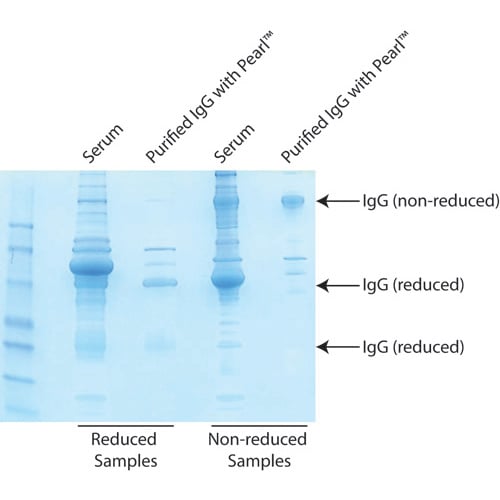This guide applies to many, but not all antibodies. Always consult the product insert of the antibody for storage and handling instructions.
Antibodies are host proteins produced in response to foreign molecules (also known as antigens). Antibodies exhibit a high degree of specificity against an antigen. Vertebrate immune systems are capable of generating an antibody response to virtually any kind of molecule. Thus, antibodies represent an inexhaustible repertoire of biologically specific molecules.
This makes antibodies a very useful tool for cell biologists, biochemists and protein-chemists. Although antibodies are powerful therapeutic and research tools, antibody molecules are vulnerable and can easily lose their activity if not handled properly. To make the best out of the antibodies, certain guidelines should be followed.
On receiving your antibody vial
The company will usually ship your antibody vial on blue ice (-20°C) which ensure that antibodies are not exposed to high temperatures or freeze-thaw during transit. Most antibodies can remain stable at 4°C for 7-12 days. However, we recommend that once you receive the antibody vial, you must thaw it and aliquot it immediately.
Small aliquots should be made, use small microfuge tubes pre-conditioned at 4°C to aliquot and store the antibodies. It is important to note that aliquots should not be smaller than 10 µL in volume. Smaller aliquots tend to suffer critical changes in antibody concentration due to evaporation and sticking of antibody to the surface of vials.
Once an aliquot has been thawed it should be labelled and remaining antibody should be stored at 4°C, never frozen again.
Long term storage of antibodies
Always store antibodies at temperature mentioned on manufacturers manual. However, antibodies that are coupled to enzymes or fluorophores are usually not stored at-20°C to avoid loss of enzyme activity or damage to the fluorophore. They are always stored at 4°C. This includes antibodies conjugated to HRP, alkaline phosphatase or abzymes.
Antibodies that are conjugated to fluorophore must be protected from the light.
Avoid keeping antibody aliquots in a frost-free refrigerator, frost-free refrigerators decrease the moisture content of the antibody solutions. One may experience dramatic changes in concentration of antibody stored in a frost-free refrigerator. Moreover, these freezers cycle between freezing and thawing to prevent frost build-up and this may eventually denature the antibodies over a period of time.
A 50% (1:1 (v/v) water: glycerol) solution makes a good cryoprotectant. Antibodies resuspended in 50% glycerol can be stored at -20°C but not recommended to be stored at -80°C because the freezing point of 50% glycerol lies close to -26°C. At temperatures around -20°, C glycerol keeps a fluid form but on freezing at -80°C, ice crystals can form and damage the antibodies.
Storage at -80°C is only recommended for very long-term storage (>5 years) and it is recommended to add BSA (1mg/mL) to the antibody-glycerol solution in that case.
The antibody has Sodium Azide added as a preservative, what should you do?
Sodium azide (usually used at 0.02% (w/v)) is a potent antimicrobial agent and prevents fouling of antibodies, but it is also toxic to cells and animals. Therefore, for any in-vivo experiments requiring antibody, it becomes necessary to remove sodium azide from the antibody solution. Sodium azide can also interfere with the conjugation of antibodies using amino functionalities. And if antibodies are to be used for conjugation in a co-immunoprecipitation experiment, Sodium azide should be removed first. Merthiolate can be used for long term storage of such antibodies, as it doesn’t interfere with amine coupling reactions.
An efficient method for the removal of sodium azide is dilution of the antibody solution with the appropriate buffer followed by an antibody clean up kit. Spin column technology is effective at removing interfering contaminants such as sodium azide.
How to handle animal serum or Ascites fluid.
Sometime you may get the serum or ascites fluid from the animal, these fluids contain antibodies and one need to purify the antibodies from rest of the serum components. Ascites fluid may contain proteases and therefore it should either be immediately processed or stored frozen until it is used or processed further. The IgG fraction which contains antigen-specific antibodies can be purified using Protein A/G. Protein G and Protein A are proteins of bacterial origin derived from group G-Streptococci and Staphylococcus aureus respectively. These proteins are often conjugated to sepharose or agarose beads and can be used to purify or isolate IgG molecules with high efficiency.
IgG antibodies thus purified needs further steps to ensure long term shelf-life retaining maximum activity. It is advisable to store the purified antibodies at high concentrations, storing antibodies at high concentrations prolongs their shelf-life. A minimum recommended concentration is 1mg/mL. The purified antibody should be filter sterilized using a .45-micron filter before storing.
Some isotypes are more susceptible to aggregate and lose activity, for example, IgG3 is very prone to form aggregates and therefore should always be stored at 4°C.






